Structure of the Sun
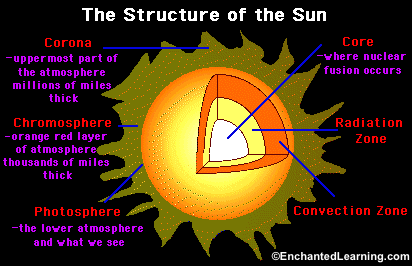
The Core: The Sun's core has a
tremendously high temperature and pressure. The temperature is roughly 15 million °C. At this temperature, nuclear fusion
occurs, turning four hydrogen nuclei into a single helium nucleus plus a LOT of energy. This "hydrogen burning" releases gamma
rays (high-energy photons) and neutrinos (particles with no charge and almost no mass).
The
Radiative Zone (or radiation zone): The next layer out from the core is this zone which emits radiation. This radiation
diffuses outwards. The temperature ranges from 15 million °C to one million °C. It may take photons of radiation millions
of years to pass through the radiative zone, as they gradually make their way outwards.
The
Convective Zone: In this next layer, photons continue to make their way outwards via convection (towards lower temperature and pressure). The temperature ranges from one million °C
to 6,000 °C.
The Photosphere: This is the lower atmosphere of the Sun and the part
that we see (since it emits light at visible wavelengths). This layer is about 300 miles (500km) thick. The temperature is
about 5,500 °C.
The Chromosphere: This reddish layer is an area of rising temperatures.
The temperature ranges from 6,000 °C (at lower altitudes) to 50,000 °C (at higher altitudes). This layer is a few thousand
miles (or kilometers) thick. It appears red because hydrogen atoms are in an excite state and emit radiation near the red
part of the visible spectrum.
The Chromosphere is visible during solar eclipses (when the moon blocks the Photosphere).
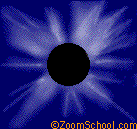 The Corona: This is the outer layer of the Sun's atmosphere. The corona extends for millions
of miles and the temperatures are tremendous, reaching one million °C. The Corona: This is the outer layer of the Sun's atmosphere. The corona extends for millions
of miles and the temperatures are tremendous, reaching one million °C.
Holes in the corona occur where the Sun's magnetic
field loops out into space. These coronal holes may be the source of the solar wind, a stream of energetic particles that
permeate the Solar System.
Solar Rotation
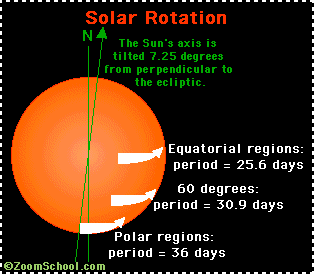 The Sun rotates around an axis which is roughly perpendicular to the plane of the ecliptic; the Sun's rotational axis is tilted by 7.25° from perpendicular
to the ecliptic. It rotates in the counterclockwise direction (when viewed from the north), the same direction that the planets
rotate (and orbit around the Sun). The Sun rotates around an axis which is roughly perpendicular to the plane of the ecliptic; the Sun's rotational axis is tilted by 7.25° from perpendicular
to the ecliptic. It rotates in the counterclockwise direction (when viewed from the north), the same direction that the planets
rotate (and orbit around the Sun).
The Sun's rotation period varies with latitude on the Sun since it is made of gas.
Equatorial regions rotate faster than polar regions. The equatorial regions (latitude = 0 degrees) rotate in about 25.6 days.
The regions at 60 degrees latitude rotate in about 30.9 days. Polar regions rotate in about 36 days.
The Size of the Sun
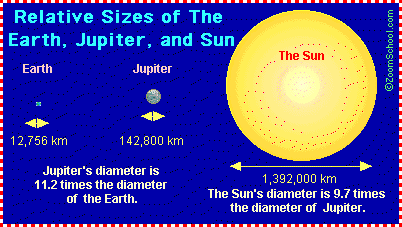 The Sun's diameter is 864,938 miles (1,391,980 km). This is almost
10 times larger than the planet Jupiter and about 109 times as big as the Earth. The volume of the Sun is 1,299,400 times
bigger than the volume of the Earth; about 1,300,000 Earths could fit inside the Sun The Sun's diameter is 864,938 miles (1,391,980 km). This is almost
10 times larger than the planet Jupiter and about 109 times as big as the Earth. The volume of the Sun is 1,299,400 times
bigger than the volume of the Earth; about 1,300,000 Earths could fit inside the Sun
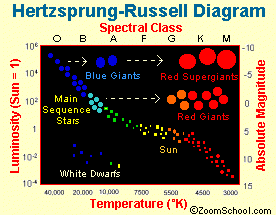 As compared to other stars, however, the Sun is about average; red giants like Betelgeuse are about 700 times bigger than
our Sun (and roughly 50 times as massive). Betelgeuse is also about 14,000 times brighter than the Sun. Red supergiants dwarf
the Sun. As compared to other stars, however, the Sun is about average; red giants like Betelgeuse are about 700 times bigger than
our Sun (and roughly 50 times as massive). Betelgeuse is also about 14,000 times brighter than the Sun. Red supergiants dwarf
the Sun.
The Sun's apparent size in our sky is 32 arc minutes (it is the biggest object in the sky - 1 arc minute
larger than the moon).
THE MASS OF THE
SUN
The Sun's mass is roughly 1.99 x 1030
kg. This is about 333,000 times the mass of the Earth. The Sun contains 99.8% of all of the mass of the Solar System.
The mass of the sun is decreasing over time, as fusion reactions convert hydrogen
into helium, releasing huge amounts of energy in the process.
Sunspots
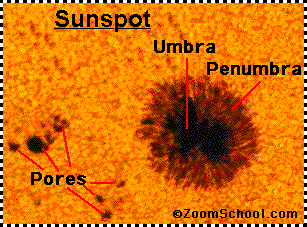  Sunspots are relatively cool, dark patches on the sun's surface. They come in many shapes and sizes; they
often appear in groups. These spots are much bigger than the Earth; they can be over 10 times the diameter of the Earths. Sunspots are relatively cool, dark patches on the sun's surface. They come in many shapes and sizes; they
often appear in groups. These spots are much bigger than the Earth; they can be over 10 times the diameter of the Earths.
Individual
sunspots only last for one to two weeks, but the number of sunspots follows an 11 year cycle. The current sunspot cycle will peak in the middle of 2000. Sunspots are visible from Earth.
The
sunspot cycle was discovered by S. Heinrich Schwabe in 1843 (he started his observations in 1826).
WARNING: do
NOT look at the sun; it can damage your eyes permanently!
UMBRA:
The umbra is the inner, dark, cool
(3700 K = 6600 °F = 3400 °C) region of a sun spot. The umbra of a sunspot can be up to 12,000 miles (20,000 km) wide. In the
umbra, the Sun's magnetic field is very strong.
PENUMBRA:
The penumbra is the outer, relatively light region
of a sun spot. It is shaped like an annulus (a ring) surrounding the darker, cooler umbra.
PORES:
A pore
is a small sunspot that doesn't have a penumbra. Pores are up to about 1,500 miles (2,500 km) across and are lighter
than a sunspot's umbra.
GRANULATION:
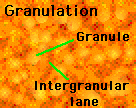 Granulation is solar granules together with intergranular lanes (dark, cool areas between granules where solar material is
descending into the surface). Granulation covers the visible surface (the photosphere) of the Sun. Granulation is solar granules together with intergranular lanes (dark, cool areas between granules where solar material is
descending into the surface). Granulation covers the visible surface (the photosphere) of the Sun.
GRANULES:
Granules are regions of the sun where hot solar material comes
to the solar surface. Granules are about 600 miles (1,000 km) across and only exist for about 5 to 10 minutes before they
fade away. It is almost as though the surface of the Sun is bubbling like a pot of boiling water.
What Causes Sunspots?
Sunspots occur where the
sun's magnetic field loops up out of the solar surface and cool it slightly, making that section less bright. These disturbances
in the sun's magnetic field make the sunspot about 2700°F (1500°C) cooler than the surrounding area.
Solar Flares, Prominences, the Solar Wind, and Coronal Mass Ejections
SOLAR FLARES
A solar
flare is a magnetic storm on the Sun which appears to be a very bright spot and a gaseous surface eruption. Solar flares release
huge amounts of high-energy particles and gases and are tremendously hot (from 3.6 million to 24 million °F). They are ejected
thousands of miles from the surface of the Sun.
Solar flares were first observed by in 1859 by Lord Richard C. Carrington. He wrote
that as he was watching the sun with a telescope, he saw "two patches of intensely bright and white light" near a huge group
of sunspots. Just a few seconds later, the flare has disappeared.
It has been recently discovered that solar flares
can cause sunquakes. Sunquakes are violent seismic events on the Sun. When a sunquake occurs, energy is released in seismic
waves on the relatively fluid surface of the Sun. These waves radiate in concentric circles from the epicenter of the sunquake.
These seismic waves seem to be compression waves (perhaps like "P" waves generated by earthquakes). Sunquakes would rate about
11.3 on the Richter scale. These huge quakes release about 40,000 times more energy than the 1906 San Francisco earthquake.
Sunquakes were first observed by Alexander G. Kosovichev (Stanford University) and Valentina V. Zharkova (Glasgow Univ., UK).
SOLAR WIND
The solar wind is a continuous stream of ions (electrically charged particles) that are given off by magnetic anomalies on the Sun.
The solar wind is emitted where the Sun's magnetic field loops out into space instead of looping back into the Sun. These
magnetic anomalies in the Sun's corona are called coronal holes. In X-ray photographs of the Sun, coronal holes are black
areas. Coronal holes can last for months or years.
It takes the solar wind about 4.5 days to reach Earth; it has a
velocity of about 250 miles/sec (400 km/sec). Since the particles are emitted from the Sun as the Sun rotates, the solar wind
blows in a pinwheel pattern through the solar system. The solar wind affects the entire Solar System, including buffeting
comets' tails away from the Sun, causing auroras on Earth (and some other planets), the disruption of electronic communications
on Earth, pushing spacecraft around, etc.
SOLAR PROMINENCE
 A solar prominence (also known as a filament) is an arc of gas that erupts from the surface of the Sun. Prominences can loop
hundreds of thousands of miles into space. Prominences are held above the Sun's surface by strong magnetic fields and can
last for many months. At some time in their existence, most prominences will erupt, spewing enormous amounts of solar material
into space. A solar prominence (also known as a filament) is an arc of gas that erupts from the surface of the Sun. Prominences can loop
hundreds of thousands of miles into space. Prominences are held above the Sun's surface by strong magnetic fields and can
last for many months. At some time in their existence, most prominences will erupt, spewing enormous amounts of solar material
into space.
CORONAL MASS EJECTION
Coronal mass ejections (abbreviated CME's) are huge, balloon-shaped plasma bursts that come from the Sun. As these bursts of solar wind rise above the Sun's corona, they move along the Sun's
magnetic field lines and increase in temperature up to tens of millions of degrees. These bursts release up to 220 billion
pounds (100 billion kg) of plasma. CME's can disrupt Earth's satellites. CME's usually happen independently, but are sometimes
associated with solar flares.
THE BIRTH OF THE SUN
A Globule of Gas:
 The Sun, like other stars, was formed in a nebula, an interstellar cloud of dust and gas (mostly hydrogen). These stellar nurseries
are abundant in the arms of spiral galaxies (like our galaxy, the Milky Way). The Sun, like other stars, was formed in a nebula, an interstellar cloud of dust and gas (mostly hydrogen). These stellar nurseries
are abundant in the arms of spiral galaxies (like our galaxy, the Milky Way).
In the stellar nursery, dense parts
of the clouds undergo gravitational collapse and compress to form a rotating gas globule.
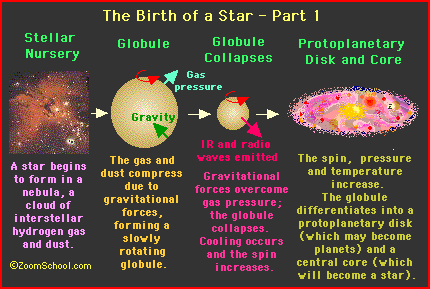
The globule is cooled by emitting radio waves and infrared radiation.
It is compressed by gravitational forces and also by shock waves of pressure from supernova or the hot gas released from nearby
bright stars. These forces cause the roughly-spherical globule to collapse and rotate. The process of collapse takes from
between 10,000 to 1,000,000 years.
A Central Core and a Protoplanetary Disk:
As the collapse proceeds,
the temperature and pressure within the globule increases, as the atoms are in closer proximity. Also, the globule rotates
faster and faster. This spinning action causes an increase in centrifugal forces (a radial force on spinning objects) that
causes the globule to have a central core and a surrounding flattened disk of dust (called a protoplanetary disk or accretion
disk). The central core becomes the star; the protoplanetary disk may eventually coalesce into orbiting planets, asteroids,
etc.
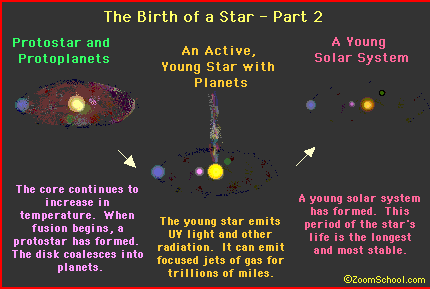
Protostar:
The contracting cloud heats up due to friction
and forms a glowing protostar; this stage lasts for roughly 50 million years. If there is enough material in the protostar,
the gravitational collapse and the heating continue.
A Newborn Star:
 When a temperature of about 27,000,000°F is reached, nuclear fusion begins at the core of the Sun. This is the nuclear reaction in which hydrogen atoms are converted to helium atoms plus energy. This energy (radiation) production prevents further contraction
of the Sun. When a temperature of about 27,000,000°F is reached, nuclear fusion begins at the core of the Sun. This is the nuclear reaction in which hydrogen atoms are converted to helium atoms plus energy. This energy (radiation) production prevents further contraction
of the Sun.
Young stars often emit jets of intense radiation that heat the surrounding matter to the point at which
it glows brightly. These narrowly-focused jets can be trillions of miles long and can travel at 500,000 miles per hour. These
jets may be focused by the star's magnetic field.
Later, the Sun stabilizes and becomes a yellow dwarf, a main sequence star which will remain in this state for about 10 billion years. After that, the
hydrogen fuel is depleted and the Sun begins to die.
THE DEATH OF THE SUN
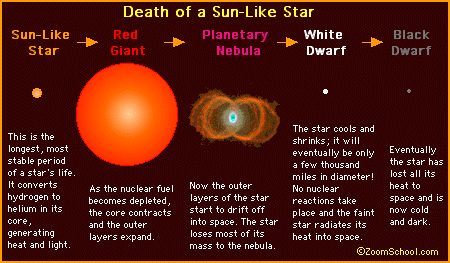
The Sun is about 4.5 billion years old. it has used up about half of its
nuclear fuel (hydrogen). In about 5 billion years from now, the sun will begin to die.
As the Sun grows old, it will
expand. As the core runs out of hydrogen and then helium, the core will contact and the outer layers will expand, cool, and
become less bright. It will become a red giant star.
After this phase, the outer layers of the Sun will continue to
expand. As this happens, the core will contract; the helium atoms in the core will fuse together, forming carbon atoms and
releasing energy. The core will then be stable since the carbon atoms are not further compressible.
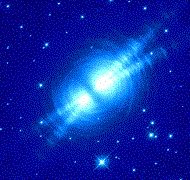
The Egg nebula: a planetary nebula that formed a few hundred years ago. | Then the outer layers of the Sun drift off into space, forming a planetary nebula
(a planetary nebula has nothing to do with planets), exposing the core.
Most of its mass will go to the nebula. The
remaining Sun will cool and shrink; it will eventually be only a few thousand miles in diameter!
The star is now a white dwarf, a stable star with no nuclear fuel. It radiates its left-over heat for billions of years. When its heat is all dispersed,
it will be a cold, dark black dwarf - essentially a dead star (perhaps replete with diamonds, highly compressed carbon).
|
Sun Statistics |
|
Mass (kg) |
1.989e+30 |
|
Mass (Earth = 1) |
332,830 |
|
Equatorial radius (km) |
695,000 |
|
Equatorial radius (Earth = 1) |
108.97 |
|
Mean density (gm/cm^3) |
1.410 |
|
Rotational period (days) |
25-36* |
|
Escape velocity (km/sec) |
618.02 |
|
Luminosity (ergs/sec) |
3.827e33 |
|
Magnitude (Vo) |
-26.8 |
|
Mean surface temperature |
6,000°C |
|
Age (billion years) |
4.5 |
|
Chemistry
* The Sun's
period of rotation at the surface varies from approximately 25 days at the equator to 36 days at the poles. Deep down, below
the convective zone, everything appears to rotate with a period of 27 days.
| Hydrogen
Helium
Oxygen
Carbon
Nitrogen
Neon
Iron
Silicon
Magnesium
Sulfur
All
others |
92.1%
7.8%
0.061%
0.030%
0.0084%
0.0076%
0.0037%
0.0031%
0.0024%
0.0015%
0.0015% |
|

